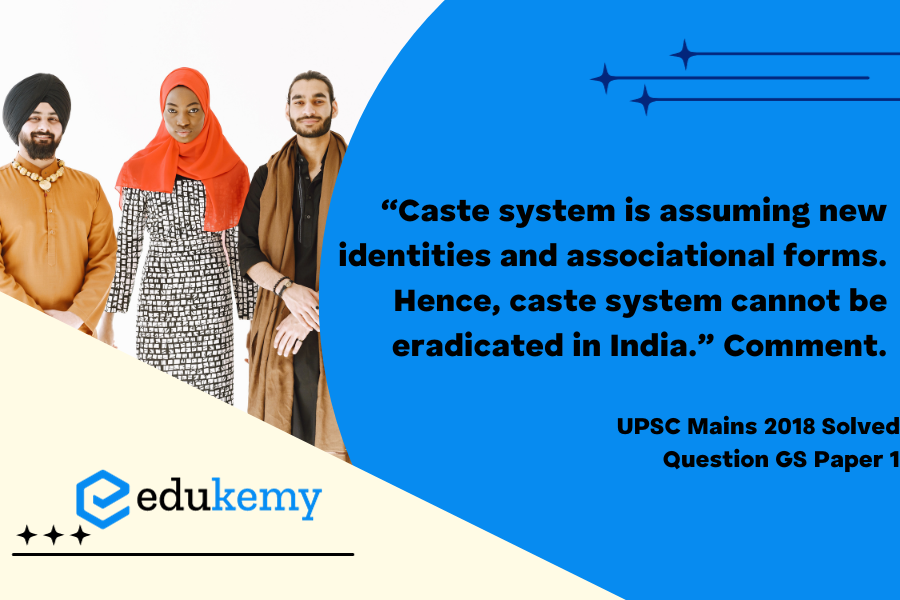The caste system in India, a deeply ingrained social hierarchy, is undergoing a transformative evolution, adopting new identities and associational forms that challenge traditional notions of hierarchy. Despite efforts to eradicate it, the caste system’s resilience lies in its adaptability to contemporary socio-political dynamics. The multifaceted nature of this ancient social structure allows it to morph into different manifestations, making its complete elimination a formidable task. In modern India, caste identities are not merely confined to rigid occupational roles but have expanded to encompass diverse socio-economic, political, and educational dimensions. The emergence of caste-based associations, both online and offline, further perpetuates its existence by providing platforms for social mobilization. While legislative measures have aimed at fostering equality, the deeply rooted cultural and historical aspects of the caste system persist. Thus, the assertion that the caste system cannot be eradicated in India gains credence as it continues to reinvent itself, adapting to contemporary challenges and maintaining a complex presence in the social fabric.
Tag: Salient features of Indian Society.
Contents
Decoding the Question:
- In the Introduction, start with the definition of caste.
- In Body, elaborate on how the caste system is taking new identities and forms and mention where it is irrelevant.
- Conclude with stating the current scenario and a positive way to eradicate it.
Answer:
Caste refers to a broad hierarchical institutional arrangement along which basic social factors like birth, marriage, food-sharing, etc are arranged in a hierarchy of rank and status. These sub-divisions are traditionally linked to occupations and decide the social relations concerning other upper and lower castes.

New identities and associational forms:
- Political: In contrast to the older structure, various caste communities have asserted themselves by forming political parties based on caste identities.
- For example- the Bahujan Samaj Party. Political mobilization based on caste has been rising. Lingayats demand to be considered a minority community.
- Economic: Development policies targeting the backward castes and schedule have benefitted only a section of the population. These sections have emerged as the elite and this has created a division within the backward castes. Also, the welfare policies have led to social stigma among the castes which are not included. These policies have strengthened caste-based mobilization.
- For example: Dominant castes like Marathas, kapus, and Patidars have been demanding reservations. Socially empowered and landholding communities like Jats have also mobilized themselves and have demanded reservation.
- Social: Under the impact of globalization and technological advancement, the strict codes of marriage and inheritance have diluted with more inter-caste marriages taking place. Caste groups like Khap Panchayats have been brought under the scrutiny of the judiciary. The expression of social exclusion and maintaining the caste-based division by the communities has however not vanished but has changed to become more subtle.
- For example- Matrimonial advertisements are frequent in the newspapers that especially demand brides and grooms from particular communities.
It is becoming irrelevant in some areas:
- The most critical rule among the caste regarding purity was commensality or regulations regarding eating and drinking with or receiving food and water from other castes.
- Students of different castes, unaware of commensal rules, freely ate with each other in school and at large public gatherings, i.e., marriages, and inter-caste mingling happened without commensal rules being adhered to.
- Inter-caste marriages have become relatively common in urban areas and cities.
- Marriage is also a result of the free choice of two partners, the role of caste in determining the match is declining.
Considering that these divisions offer solidarity and psychological strength to various marginalized groups. The caste system in India is bearing changes due to progress in education, technology, modernization, and changes in general social outlook. However, despite the general improvement in situations of the lower castes, India has still a long way to go, to root out the evils of the caste system from society.
In case you still have your doubts, contact us on 9811333901.
For UPSC Prelims Resources, Click here
For Daily Updates and Study Material:
Join our Telegram Channel – Edukemy for IAS
- 1. Learn through Videos – here
- 2. Be Exam Ready by Practicing Daily MCQs – here
- 3. Daily Newsletter – Get all your Current Affairs Covered – here
- 4. Mains Answer Writing Practice – here


